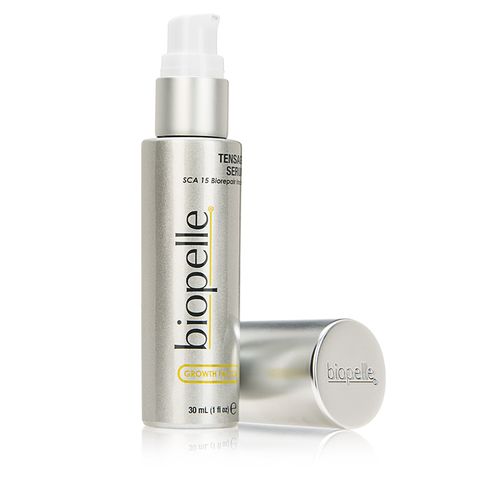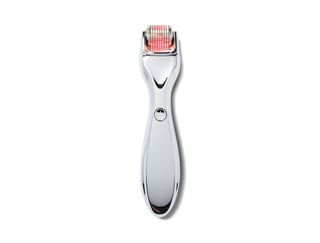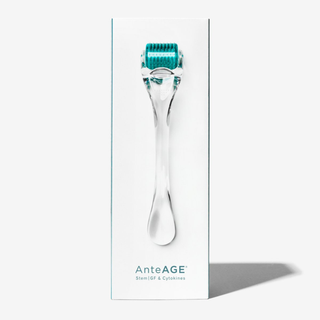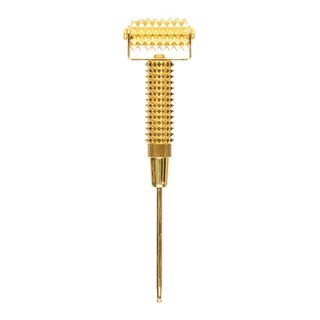I know I’m not alone when I say that the current lockdown has been both a blessing and a curse for my skin. What’s great about the lockdown is that I can really work on my acne without fear of air pollution, dirt, and debris from my daily commute, triggering breakouts. Then, there’s the downside. Thanks to lockdown mandates, many of us (myself included) cannot treat said breakouts with monthly facials or trips to the derm’s office. Instead, I’ve been searching for ways to supplement professional services with at-home treatments—safely, of course. Enter: Dermarolling.
At first glance, the handheld machine comes off as intimidating. Rolling miniature needles up, down, and across my face is supposed to help combat acne scarring and evening out my skin tone? According to Tiffany Markarian, licensed esthetician and founder of Glowmode Skincare, dermarolling does all of that and so much more. Before taking things into my own hands, I polled Markarian about the procedure, best practices, and who benefits from dermarolling.
What is dermarolling?
“So, there’s the dermaroller—the manual device—and then there’s microneedling, which is the basic technique. The common size for a dermaroller is 0.25 and what those needles do is make a little microchannel into the skin so the product or serum will penetrate deeper into the skin,” Markarian explains to me. Whatever serum you choose to use will fill into those tiny incisions created by the dermaroller to allow the product to work its magic. But there’s more.
“What’s also happening is, in that little controlled wound that we made with that little teeny needle, it triggers ATP, which helps energize the cells and gets everything moving faster. The deeper the needle depth, the better it is for scarring.”
Who would benefit most from dermarolling?
While dermarolling has a slew of benefits for different skin types, Markarian suggests those battling acne scars could see great results from incorporating a dermaroller in their routine. “It all depends upon what serums you’re using because you want the product to penetrate deeper to minimize the appearance of scarring,” she says. “Using a dermal roller at 0.25 with a particularly high-quality vitamin C serum would make a huge improvement in clearing up their scarring.” But she wouldn’t go as far as to say it would take away the scarring completely. She does recommend microneedling for those with rosacea. “Microneedling is wonderful for rosacea because you would be using a serum that would also be treating the rosacea, so anything hydrating. Those hydrating ingredients would penetrate deeper; therefore, their skin would reap the benefits of it much more than if they just applied it on the skin.”
For people who should stay away from dermarolling, Markarian says people with active breakouts, active acne, especially inflamed acne because when using a dermaroller, you’re going to poke a needle through that inflammation and it could lead to more inflammation,” she explains.
Can you walk me through the process from start to finish?
- First, cleanse your skin thoroughly and follow up with a hydrating toner.
- Next, apply your treatment serum. If your goal is to lessen acne scars’ appearance, go for a serum with brightening agents.
- Begin the dermarolling process by doing three passes. So, you want to do upward, sideways, and then diagonal. You do three separate passes. It’s not so important the direction that you’re doing it. It’s more important that there are passes up into your jawline.
- Then, follow up with another layer of your serum, the treatment serum that you use.
Because you are making little incisions, will you draw blood? Do you cleanse your face all over again?
“Because you’re using a 0.25 needle, the depth is very shallow. However, everyone’s face is different. If you do find any little pinprick of blood that arrives at the surface, then wipe it off with the hydrating toner. Re-apply another layer of the serum, a moisturizer, and that’s it.
After dermarolling, are there specific products that you shouldn’t put on your face to avoid burning or extra irritation?
Markarian says to stay away from exfoliating serums—scrubs and chemical exfoliants. “Any exfoliating serum-like any alpha-, beta-hydroxy, vitamin a, any of that. The idea is to hydrate and moisturize afterward,” she adds. “Your skin might feel a little warm. You may have a little pinkness to the skin but wouldn’t need a whole post-treatment microneedling routine. You could just add a serum, moisturize, and feel worry-free.”
How soon should someone be looking in the mirror for radiant, glowy skin?
If you expected anything sooner than a week, I have news for you. “By day 21,” Markarian said. Nott an ideal timeline, but good things take time. Markarian says the best way to track your results would be to take photos. “Take a picture on day one, in your bathroom or in front of the window. And then, take a picture on day 21. The thing is that nobody notices incremental changes from their face. You have to take that picture. So, I would say on day 21 is really when you start to see changes.”
This content is created and maintained by a third party, and imported onto this page to help users provide their email addresses. You may be able to find more information about this and similar content at piano.io





